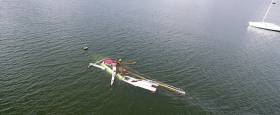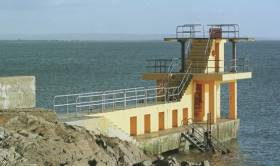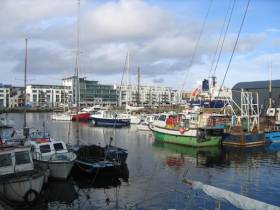Displaying items by tag: Galway
Bodies Recovered From Galway Waters In Search For Missing Men
#Galway - BreakingNews.ie reports that post-mortems on two bodies recovered from Galway waters over the weekend are scheduled for today (Monday 18 April).
Gardaí have confirmed that the body of soldier Private Ben Garrett (21), who was missing since 31 March, was recovered from Galway Docks on Sunday morning (17 April).
Another body was found in Galway Bay on Saturday morning (16 April) in the search for Anthony Henehan, last seen entering the water at Wolfe Tone Bridge in Galway city on 10 March.
A much-admired ongoing restoration project, which had resulted in the full return to original condition of the classic sloop-rigged 26ft South Coast One Design Pegasus, almost ended in tragedy with an explosion aboard the newly-launched boat on the Galway Bay SC moorings at Rinville near Oranmore at the weekend.
What would have been the boat’s second full season after her restoration ended before it had properly begun. She was rigged and ready to have her sails set, but an attempt to boil a kettle resulted in the gas explosion which blew the deck and cabin off the hull, set the hull on fire, brought the mast down, and sank the boat within one and a half minutes.
Fortunately both sailors on board were wearing lifejackets, and despite their burns and injuries, were able to get to a nearby boat. But while one of them was later released from hospital after treatment for burns, the other has been kept in for observation, though it is thought his injuries are not serious.
Public Hearing In Galway On Blackpool Diving Tower Upgrades
#Galway - Next Wednesday is the date for a public consultation on planned upgrades and repairs to the Blackpool Diving Tower in Salthill.
As the Galway Advertiser reports, the hearing will take place at the Salthill Hotel from 7pm to 10pm on Wednesday 30 March.
#Search - Galway Bay FM reports that coastal searches resumed this afternoon in Galway for a man who was spotted entering the water last night (Thursday 10 March).
The search began in Galway Docks after the man, believed to be in his 30s, was seen entering the water at Wolfe Tone Bridge over the Corrib, but no trace has been found.
A separate search for a person calling for help on the shoreline near Mutton Island has also yielded no results thus far, and it is not yet known if the two events are related.
Galway Lifeboat Gets Tech Upgrade
#RNLI - Galway's inshore lifeboat has had a €100,000 upgrade, as the Connacht Tribune reports.
The Atlantic 85 RIB has been kitted out with some of the latest in lifesaving technology – and all of it was funded by public donations to the RNLI.
“You’re looking at two new engines, a new navigation system, and a new chart plotter," says Galway RNLI lifeboat operations manager Mike Swan on the boat, named 'Binny' upon its introduction in late 2012.
The Connacht Tribune has more on the story HERE.
Atlantic Youth Trust Hosting Inaugural Gala In March
#TallShips - The Atlantic Youth Trust is set to host its inaugural conference and gala ball in Galway this March, as the Galway Independent reports.
The sail training tall ship project, which recently hailed its inclusion in the new implementation plan for the Stormont Agreement, will hold the event at the Galway Bay Hotel on Saturday 12 March – in the same city that's prepping a bid to attract the Tall Ships Races in 2019.
Besides hosting an evening of keynote speakers and an afternoon of workshops, the day is also intended to double as a fundraiser for a West of Ireland Bursary Fund for youth sail training along the lines of those already established in Drogheda and West Cork.
As previously reported on Afloat.ie, the Atlantic Youth Trust proposes the construction of a new tall ship to replace the Asgard II as a symbol of cross-border unity and a practical training vessel to teach adaptable skills for young people.
The Galway Independent has much more on the story HERE.
Search For Missing Woman In Galway City River
#Missing - Galway Bay FM reports that emergency services are searching for a woman seen entering the River Corrib in the Galway city around 2.30am this morning (Sunday 31 January).
The missing woman was last spotted entering the water from the walkway between O'Brien's Bridge and Newtownsmith, but so far there has been no trace of her whereabouts.
Update: Galway Bay FM now reports that a body as yet unidentified has been recovered from the water in Galway Harbour.
Galway Councillors Point Finger At NPWS Over Flood Relief Barriers
#Flooding - Galway county councillors have blamed the National Parks and Wildlife Service for blocking flood prevention measures.
Galway Bay FM reports on a special sitting of Galway County Council, which heard a number of members take the NPWS to task over what they perceived as putting protections for wildlife over those of hundreds of families in the county affected by the recent severe flooding along the Shannon.
Cllr Michael Connolly claimed relief works planned for Meelick were halted over concerns with a single fish species – while Cllr Michael Fahy scoffed that digging emergency channels was more important than "bats and the bees".
Galway Bay FM has more on the story HERE.
Drone Video Reveals Extent Of Lough Neagh Flooding
#LoughNeagh - Drone footage of the dramatic flooding around Lough Neagh has garnered over 7,000 views on YouTube.
According to the News Letter, hundreds have been flocking to the region to see the effects of flood waters as the lough's level reached a 30-year high.
However, any potential benefits in visitor numbers are far outweighed by the severe cost to local businesses, as previously reported on Afloat.ie.
And flooding around the lough will continue to be a problem for the foreseeable future due to a combination of poor water flow control and unreliable long-range weather forecasts.
That was the stark warning from Rivers Agency chief David Potter speaking to a Storming committee earlier this week, as the Belfast Telegraph reports.
"In order to reduce the lough by a foot, we need between 25 and 38 days' notice, and after about five days our level of confidence in the weather forecast is pretty shaky," he said.
"Hopefully that describes the dilemma that we are in. We can't anticipate to the extent that people believe we can."
Meanwhile, a meeting in Brussels this week has dismissed as a myth the notion that EU regulations have prevented flood relief in Co Galway, which is still suffering the effect of December's winter storms.
As Galway Bay FM reports, MEP Marian Harkin revealed that Ireland has made only one application for works of overriding public interest in the last 20 years, as the vast majority of decisions are taken at member state level.
Body Recovered From Sea In Search For Missing Galway Student
#Missing - A body recovered from the sea near Galway City yesterday is believed to be that of missing student Michael Bulger, as TheJournal.ie reports.
The body was spotted offshore by a search party volunteer near Ardfry Point in Oranmore, south-east of the city on Galway Bay.
The 20-year-old from Clare, a student at NUI Galway, was last seen leaving a bar in the city's Quays district around 1am on Friday 18 December.
Hundreds of volunteers had joined search teams to comb the city and surrounds over the weeks since for any sign of his whereabouts.
TheJournal.ie has more on the story HERE.
































































